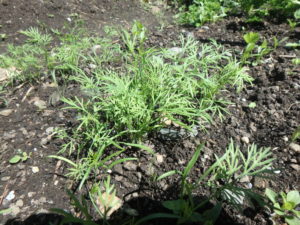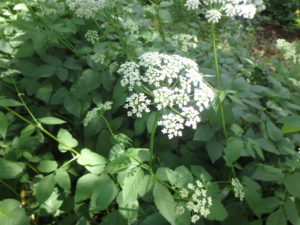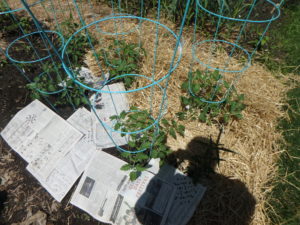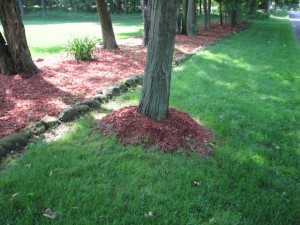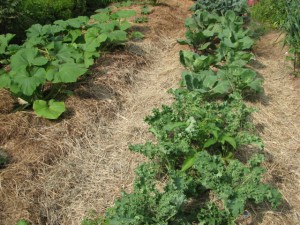Thinning, Weeding and Watering Made Easy
With the advent of summer, it is time to buckle down and get a few tedious jobs done in the garden. But there are ways to lighten your load.
First, it is time to thin out extra plants that are crowding each other. Carrots and beets are two common culprits of crowding, and if you want sizable root crops, you need to thin them.
Carrot seeds are tiny, so we don’t often plant them one-by-one. Instead we tend to sprinkle them and –by gum- most of them grow. I maintain that thinning carrots needs to happen by the Fourth of July, so get to work. If they are real close together, you may want to use scissors to cut off the extras at the soil line to avoid pulling up carrots you are trying to save.
One way to minimize the need to thin carrots is to buy pelleted seeds next time. These are seeds that come coated with a thin layer of clay. Each is the size of a BB and can be individually planted. Plant them an inch apart and you can skip the July 4th job. As they get bigger, you can eat the carrots you thin, giving them a 2-inch spacing by mid-summer.
Beet seeds are large and easy to plant. So why are there clumps of beets that need to be thinned out? It’s not that you forgot your reading glasses when planting. The answer is that those “seeds” are not really seeds. They are clusters of seeds wrapped in a package like an apple, or a pear. Johnny’s Selected Seed Company, and a few others sell ‘Moneta’ beet seeds, which have just one embryo per seed. Those, if you space them well at planting time, need not be thinned.
I like to be efficient at whatever I do, and that includes keeping a relatively weed-free garden. Many weeds quickly mature, flower, and produce seeds. Your job is to keep them from producing seeds. Right now goutweed – my nemesis – is blooming in various pockets around my garden, and I don’t have time to dig it all out. But I have a 16-year old helper who uses scissors to cut off all the flowers and bag them. We send them to the dump in black plastic bags.
Other weed control methods? Keep weeds from getting the sunlight they need to grow. You can do this by mulching. In the vegetable garden I spread out newspapers over the soil and cover them with straw, hay or leaves. Four to six pages of newspaper keeps out light, inhibiting weeds. Earthworms eat the paper over the summer, and newsprint is done with soy-based inks, so you are not adding heavy metals to your soil (which was the case years ago).
This method works well on walkways and around big plants, but is more problematical for onions and carrots which are small and closer together. I use grass clippings or chopped leaves, without the newspaper, around small plants.
Mulching in the flower garden is good, too. It keeps down weeds and holds in moisture. But beware: too much mulch can keep rain from reaching the roots of your perennials. An inch or two of ground bark helps a lot, but 3 or 4 inches will keep light showers from getting to the soil.
Some gardeners use landscape fabric under bark mulch, but I do not. I find pernicious weeds eventually send roots through the fabric and this makes weeding very difficult. Landscape fabric can also constrict perennials as they expand over time, choking them.
What about plain old black plastic? I don’t use it. Sunshine breaks it down over time, and makes a mess. It also keeps air and water from getting to the soil, which must affect soil microorganisms. But it will keep weeds down in a pumpkin patch for a single season. Still, the plastic ends up in the waste stream, which I want to avoid.
If we have a dry summer, you may need to water. Established perennials should not need added water, but your vegetable garden might. I don’t favor overhead sprinklers because they water everything: plants, walkways and weeds. I prefer a watering wand, which is a device I attach to my hose. It is a 30 inch aluminum wand with a sprinkler head and a valve. I can direct the water exactly where I want it. I like a brand called Dramm because the sprinkler head allows fast, gentle watering.
Watering cans are good, too. They allow you to see just how much water you are applying. This is important for new trees, which need 5 gallons a week or so. A sprinkler hose might seem like it is delivering a lot of water, but may not be.
A good timer will deliver water while you are away on vacation. They attach to your spigot and allow you to use an overhead sprinkler or a soaker hose. I have a soaker hose I like made by Water Right and available from Gardeners Supply Company (www.gardeners.com). It’s a round polyurethane hose, and much easier to use than the old fashioned flat ones I had tried previously.
So don’t let your garden dictate your vacation schedule. With mulch and a watering system you can come back from vacation with nothing worse than a lawn that needs cutting!
You may reach Henry at henry.homeyer@comcast.net or P.O. Box 364, Cornish Flat, NH 03746. Please include a SASE if you wish a reply by mail. Read Henry’s blog at https://dailyuv.com/
To Mulch or Not to Mulch – and How?
For more than a month small trucks laden with chipped bark or wood chips have been scurrying around, unloading piles of mulch. Mulch (from the rich dark color of Mississippi mud to the orange hues of your grandmother’s pumpkin pie) has been spread over flower beds and piled high against the trunk of trees. It will hold down weeds and keep in moisture. But using mulch can have a downside, too. Let me explain.
It is important, if you are using a wood-based mulch, to put on a layer of an appropriate thickness. You shouldn’t just add a new layer of that pumpkin-colored mulch to last year’s mulch just because it’s dirty or the color has started to fade. You need to rake off the old mulch before applying a new layer. A gentle spring rain will not penetrate a 4-6 inch layer of mulch, and eventually the soil will dry out.
Next, there is the question of how mulch is applied near trees. Some landscapers favor the “volcano” look. While it is true that a 12-inch volcano of mulch will keep grass from growing up around your favorite crab apple tree, the mulch will eventually lead to bark rot, a compromised cambium layer, and a slow death. (Except for blueberries, which seem to thrive on mulch or sawdust piled right up to their stems).
Any wood-based, chipped mulch will eventually be host to fungi that break it down. Those same fungi will work on the bark of your tree and eventually break it down, too. Because it takes 6-12 years for a tree to decline and die from compromised bark, the cause and effect is not obvious. You can avoid the problem by leaving a donut hole around the tree – 6 inches of clear space between the trunk and the ring – the donut – of mulch.
Then there is the question of what is in your wood mulch? As a landscaper and garden designer I have occasionally needed to buy a few bags of wood mulch, even though I prefer to buy in bulk from a family-run business that makes its own. But when I do need to buy mulch, I read the label. If the mulch has been dyed with a chemical, I avoid it and go elsewhere to buy good mulch. Why? Because I am an organic gardener. It’s true that most gardeners only use wood-based mulch on flower gardens. Still, I don’t want chemicals introduced to my environment, or that of my clients.
Some years ago I visited radio personality Ray Magliozzi (of NPR’s Car Talk program) at his home in a Boston suburb. Ray was a late-comer to the organic movement. He became an organic gardener after his beloved collie died of cancer. He realized that the lawn jockeys he hired were spreading weed and fungus killers, along with their mowing and fertilizing. He questioned if there was a relationship between his dog’s illness and the chemicals. The same question could be asked about the chemical dye in mulch. What is it? How does it affect us?
So what are the alternatives to commercial wood-based mulch? My choice? Chopped leaves. Leaves run over by the lawnmower and saved last fall for use now. Trees mine minerals from the soil, and then shed their bounty to share with us each fall. Once wet, they don’t tend to blow away.
What about cocoa or buckwheat hulls? They are very tidy to look at and I’ve tried both, but they are very expensive to buy. Cocoa hulls, freshly applied, smell like chocolate chip cookies to me – and some dogs. I have heard that dogs can be sickened (or worse) by ingesting cocoa mulch (chocolate can be poisonous to dogs). That may be part urban myth, of course, but I tend to stay on the safe side. Cocoa hulls also tend to develop a slippery mold layer for a week or so, though it disappears eventually.
I use a layer of 4-6 sheets of newspaper covered with hay or straw in the walkways of my vegetable garden and around large plants, and it is effective at keeping down weeds. The inks are now soy-based and safe to use (in the old days the inks had heavy metals). I soak the papers overnight in a plastic bin first and drain the water in the driveway to get rid of any soluble chemicals in the papers.
Landscape fabric comes in many kinds. The good stuff is tough enough you can’t tear it with your hands; it allows rain to pass through, but little sunshine for hopeful weeds. My feed-n-grain store sells it by the foot, cutting it off a large wide roll, which is handy. It looks best with a thin layer of mulch on top. Black plastic is used by some in the vegetable garden, but it breaks down after a year and needs to go to the landfill. I avoid it.
Nature’s most persistent mulch is, of course, stone. I like small stones for walkways or occasionally in a flower bed. In either case, a layer of landscape fabric will do wonders for inhibiting weed growth.
So take a look around. If you see bark mulch being piled up on a tree trunk, make a citizen’s arrest. Or hand the culprit this article.
Henry Homeyer is a life-long organic gardener, gardening consultant, and UNH Master Gardener. His Web site is www.Gardening-guy.com.



